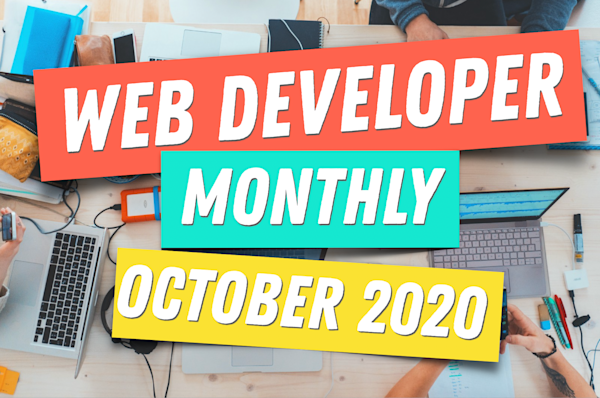11th issue! If you missed the previous ones, you can read the previous issues of the Python Monthly newsletter here.
If it’s your first time here… (otherwise, skip this part)
Being a Python developer is a fantastic career option. Python is now the most popular language with lots of growing job demand (especially in the fields of Web, Data Science and Machine Learning). You have many job opportunities, you can work around the world, and you get to solve hard problems. One thing that is hard, however, is staying up to date with the constantly evolving ecosystem. You want to be a top-performing python developer, coder, programmer, software developer, but you don’t have time to select from hundreds of articles, videos and podcasts each day.
This monthly newsletter is focused on keeping you up to date with the industry, keeping your skills sharp, without wasting your valuable time. I will be sharing the most important articles, podcasts and videos of the month. Think Tim Ferriss and the Pareto Principle (80/20 rule) meeting the Software Development world. What’s the 20% that will get you 80% of the results?
What you missed in October as a Python Developer…
Python 3.9 Is Here 🧑🏼🚀
Python 3.9 was officially released this month! You can check out the new features in the official documentation right here. You can also read a nice discussion on what people think of the new changes. By the way, Python 3.5 is now officially end of life (sounds more dramatic than it needs to be).
Python Booleans 🎭
How long can a tutorial on Python Booleans be? True and False. What's more to know? Well, it turns out, a lot. Have a read through this tutorial to discover how you can use booleans to optimize your Python code.
Weekend Project Idea 🎏
We have all heard the cool new hip tech Kubernetes by now. It's the hottest thing in the startup/tech world since React. In this weekend project you will use Python with Kubernetes to deploy your very first cluster. This way you will be prepared when you build that app that gets waaaaay more users than expected one day.
Diagrams Everywhere ⛲️
Create beautiful architecture diagrams with Python using this very uniquely named library: Diagrams. Sure, the library name does not elicit excitement, but this article showing you how to use it might.
Python and Context Management 🪀
Python’s context manager, is a replacement for try/finally blocks. It's implemented using with statement commonly used when opening files. How is this any use to us? Same as with try/finally, this pattern was introduced to guarantee that some operation will be performed at the end of the block, even if exception or program termination occurs. No idea what any of that means? Well read on here.
Python Developer Survey 👨👧👦
Python Developer Survey 2020 is officially open. Go add some data points for them so we can analyze the results later and learn about the Python Community!
Data Management With Python 💈
All programs process data in one form or another, and many need to be able to save and retrieve that data from one invocation to the next. Python, SQLite, and SQLAlchemy give your programs database functionality, allowing you to store data in a single file without the need for a database server. Learn how to use these 3 methods here.
News Around the World 🗺
- An Excel error caused 16,000 COVID results to be missed in England. Oops.
Big Tech News 🏢
-
Google has a new programmable search engine. Add the google search feature to your own website. You can also hum a song and search for the song now with Google. Ooops, and an anti trust lawsuit is happening.
-
Digital Ocean just entered the app platform game. Deploy code directly from your GitHub repositories. Automatically re-deploy the app when you push updates to your source code (similar to Netlify).
-
In case you were not aware, Google and Oracle have been in a big battle over public APIs which could have huge implications on how any public APIs of the future will be dealt with. The stakes in the case are high for Google, which could owe Oracle billions of dollars in damages. More importantly, an Oracle win could reshape how copyright law treats APIs, giving incumbents the power to lock out competitors who want to build compatible software.
-
An elite and well known group of security researches hacked Apple for 3 months. Here is what they found out. Speaking of, Apple announced a bunch of new products including their latest phone. Homepod mini uses an interesting method to keep your audio data on the local device and away from Apple servers. Finally, Apple is introducing Face ID and Touch ID for the web.
-
Zoom is joining the big players like Slack and Shopify by opening up 3rd party apps to be built on top of their platform. Keep an eye on this.
-
Facebook is using QUIC/HTTP3 for 75% of their servers and it now joins companies like Uber who are taking advantage of this modern protocol that is looking to replace TCP.
-
PayPal is going to allow cryptocurrency buying, selling and shopping on its network
Completely useless to your career but still great 🙃
-
The definition of useless to your career but still great
-
A friendly reminder that naming things in programming is probably not as hard as this
-
Visit the old internet
Best Resource of the Month 🥽
As an industry, we’ve gotten exceptionally good at building large, complex software systems. We’re now starting to see the rise of massive, complex systems built around data – where the primary business value of the system comes from the analysis of data, rather than the software directly. We’re seeing quick-moving impacts of this trend across the industry, including the emergence of new roles, shifts in customer spending, and the emergence of new startups providing infrastructure and tooling around data. At the core of these changes are programming languages like Python combined with many tools. Here is a look at common emerging architectures in modern data infrastructure.
Trick of the Month 🎩

-
Toonify yourself
-
If you have a google Pixel, you now don't have to wait on the phone... I cannot wait for this to be generally available to all phones.
-
Practice your typing skills with the classics
See you next month everyone!
If you haven't already, subscribe below to receive Python Monthly next month along with exclusive ZTM posts and offers. If you're already subscribed, please share it with someone (use those little widgets on the left) who might find it useful, they'll love you and so will we!
By the way, my full time job is to teach people how to code and get hired in the most efficient way possible as the Lead Instructor of Zero To Mastery Academy. You can see a few of my courses below or see all of my courses by visiting the courses page.






